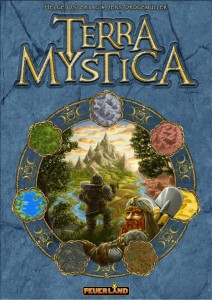 What do you get when you take 14 different races and put them in a really heavy box of eurogame components? You get one of the surprise hits to come out of Essen 2012 in the form of Terra Mystica. This eurogame takes the concept of luck and boots it right out of the window into a game that rewards strategic planning and optimization. Each player takes on one of the 14 unique races and tries to adapt the land around them to their specific domain. Can this complex eurogame satisfy your need to take over the world? Read on to find out!
What do you get when you take 14 different races and put them in a really heavy box of eurogame components? You get one of the surprise hits to come out of Essen 2012 in the form of Terra Mystica. This eurogame takes the concept of luck and boots it right out of the window into a game that rewards strategic planning and optimization. Each player takes on one of the 14 unique races and tries to adapt the land around them to their specific domain. Can this complex eurogame satisfy your need to take over the world? Read on to find out!
Terra Mystica is an economic and territory building game for 2-5 players that plays in about 90-120 minutes. Terra Mystica plays best with 4 players.
Game Overview:
In Terra Mystica, each player chooses one of the 14 different factions and must use their abilities to develop the land more successfully then their opponents. Each faction is bound to a specific type of terrain and can only build on that terrain type. Players will use the several different currencies in the game to both upgrade their civilization and also develop the land around them. During the game, players should be aware of their proximity to their opponent as it will act as a double edged sword. Being close to an opponent helps to generate power, but it also makes expansion more difficult and competitive. The game ends after 6 rounds and the player with the most victory points wins.
Components:
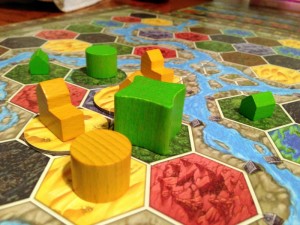
It’s usually somewhat hard to get excited over the components in a eurogame. Most of the time they are simply cardboard tokens and little wooden pieces; more functional than aesthetically pleasing. And for the most part, Terra Mystica fits that mold. But wow is this a heavy box. I’d guess it weighs around 5lbs and in that mass of wood and cardboard, you do get a lot of components.
There are 7 dual sided faction boards that players will use to house their components during the game. These are fantastically designed to aid in game play, for when a player builds a structure (represented by the many wooden pieces each player gets), what is revealed under the wooden shows the new type of income that is being generated. This helps bookkeeping in the game immensely and allows the phases to run quicker. To go with the player boards, there is also a large main board and a separate board for the cultists tracks.
Finally there are a ton of cardboard tokens to represent various things throughout the game, from replacement terrain to bonus tiles. Most notable about Terra Mystica though is the complete lack of both dice and cards. That can seem almost unheard of in a board game. I’d wager that’s one of the reasons people can say that Terra Mystica eschews luck for strategy and preparation.
How to Play:
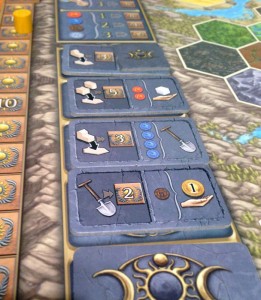
Terra Mystica really isn’t a super complex game, but learning how to play will take some time and effort. While the rulebook only has about 7 or so pages of actual game play rules, there is still a lot going on in the game and a good amount of information to wrap your head around. It’s definitely at the heavier end of the euro game spectrum. That being said, once each player has chosen a faction and the game is setup, it’s time to get started.
Terra Mystica takes place over 6 rounds, with each round being divided into 3 phases:
1. Income Phase
2. Action Phase
3. Cult Bonus and Cleanup Phase.
1. Income Phase: This phase is pretty much just how it sounds. Players collect income based on what they’ve built during the game. As mentioned above, this is excellently tracked on the player boards. Each player starts with most of their structures in a specific place on their player board. As the build/upgrade those structures, they are removed from the player board and added to the game board. Underneath each structure on the player board shows the income that’s not generated for the player. Add up all the visible symbols and you have your income for the round.
The game has a number of different currencies that players must manage. The main three are: Workers, Coins and Priests. The secondary currency is power and a tertiary currency is spades. More on all of that later.
2. Action Phase: This is where the meat of the game happens. Starting with the first player (decided by who went out first at the end of the last round), each player takes one action at a time in a clockwise manner.
Possible actions include:
1. Transform and Build: The most basic of actions. Change a terrain type next to one of your buildings and construct a new dwelling on it. This usually costs a specific number of shovels, one of the games many currencies.
2. Advance Shipping Track: This lets you build across water, as normally, you can only build on land adjacent to your current structures.
3. Lower the exchange rate for spades: Normally spades cost 3 workers to obtain, with this action, you can get a better exchange rate for your spades (2:1, 1:1).
4. Upgrade a structure: You can improve an existing structure to a better version. This will replace a current structure. This can also change your income, for example: if you replace a dwelling with a trading post, you no longer get the worker a dwelling was generating, but you now gain income from the trading post that was just built.
5. Send a priest to the cult tracks: This will move you up on one of the 4 cultists tracks. These generate victory points and power for the players. They may also generate in game bonuses depending on the round goals.
6. Power Actions: Players can spend their power to use some of the special actions on the game board. These are restricted to the first player to use them each round and are usually more efficient versions of other actions.
7. Special Actions: These are special abilities granted by a faction or a round bonus card.
8. Passing: When you are done playing for the turn, you turn in your current bonus card and grab a new one (of the ones available). If you are the first player to pass on a turn, then you get the first player token.
3. Cleanup Phase: This is mostly just retrieving markers on the board and resetting for the next round. The important thing in this phase is awarding the cultist bonus. Each round, a bonus will be revealed at the start that pertains to a players distance on one of the 4 cultist tracks. If a player has moved their marker far enough along on the relevant track, they gain whatever the listed bonus is during this phase.
And that’s the game in a nutshell. I’ve glanced over a lot of things, such as obtaining and spending power, forming towns, tile bonuses, sanctuaries, etc.. But this should give you a quick overview of what the game is about. If you want to know the full rules, you can download the rulebook here.
After the 6th round, the game ends. Bonus VPs are award to the player with the largest, continuous land area and also for whoever has moved the farthest on each of the 4 cultists tracks. The player with the most victory points wins the game.
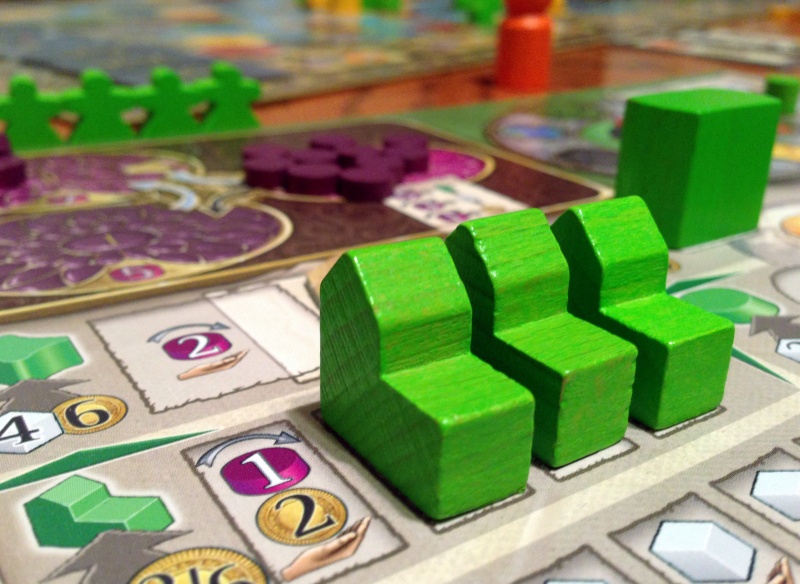
Game Experience:
That’s probably a lot to take in, but hopefully you got a decent overview of how the game is played. To be honest, I don’t actually enjoy teaching Terra Mystica all that much. It’s a heavy eurogame that has a lot going on. The rules aren’t actually that complex, but it can be a lot for a new player to wrap their head around. I’d say it usually takes a full game before players start feeling comfortable with what the game is about and how it plays.
Even for seasoned players, Terra Mystica is going to be a brain burner. With 5 different types of currencies and a wealth of options for you to do on your turn, Terra Mystica is all about positioning yourself and optimizing your civilization. Since there are no die rolls or card draws in Terra Mystica, what you see is what you get. For the most part, you’ll be making your own luck. That can be good or bad depending on your taste in games. Terra Mystica is going to throw a lot of balls at you and expect you to know how to juggle them.
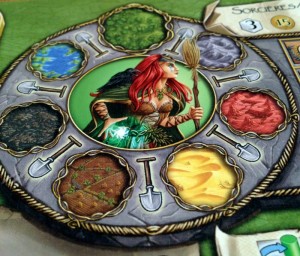
But once you get a feel for the way things works, building your civilization is a ton of fun. There are a lot of decisions to make each turn and for people that like having a lot of options, you’ll be in Heaven. From figuring out what to spend your limited resources on to where to terraform, Terra Mystica will keep you glued to the board every turn. Even when someone else is making a move, you have to calculate how that move changes your overall plans.
When I said brain burner earlier, I wasn’t kidding. This is a not a game you can take lightly as Terra Mystica demands planning and foresight. If you are the kind of person that likes to fiddle with their iPhone between turns and figure out what to do in the heat of the moment, then this probably isn’t the game for you. There is no time for idle distractions in Terra Mystica. You are gaining a limited number of resources each turn and you must spend them wisely or your will fall to the back of the pack. With only 6 turns in the game, you’ll also need to get your engine up and running as quickly as possible. Resources will always be at a premium and you’ll want them to start coming rather rapidly.
And spending those precious resources is really the crux of the game. There are tons of things you can spend them on each turn. Your goal is going to be to figure out how to get the most value for your dollar (or priest, worker, spade, power). You might really want to grab that piece of land before your opponent does, but if you are not setup properly, it could cost you all you have that turn. Is that a wise move? Only time will tell.
Speaking of your opponents, player interaction in Terra Mystica is a curious thing. There are no armies, so you won’t be attacking your opponents. You’ll actually form a love/hate relationship with your opponents. Thanks to the genius proximity system in the game, when an opponent builds or upgrades a structure next to one of yours, you gain power. Power, one of the games currencies, that you can spend on improving your own position in the game. However, that power comes at a cost (doesn’t it always?). To leech that power, you must give up some victory points according to a scale (1p for 0vp, 2p for 1vp, 3p for 2 vp, etc..).
The other concern about being near your opponents is that you will have to fight for land. This is less of an issue in a 2 player game, but in a 4-5 player game land can become a precious commodity. You don’t want to be stuck having to pay out-of-the-nose to convert a inefficient piece of land. Terraforming is done via a circle on your player board. A player’s home terrain is at the top of the circle and each step away from their home terrain the target terrain is, the more expensive it is to convert. But sometimes that’s your only option.
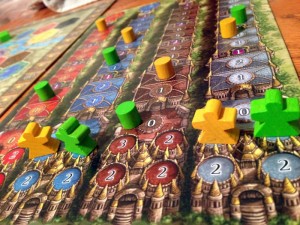
Even though there is less competition in a 2 player game, Terra Mystica still scales surprisingly well. I’ve played the game with the whole range from 2-5 players and have enjoyed each game. With two players, optimization becomes less crucial and the game is more forgiving. Players can almost sit in different parts of the map and work their own strategies. With 4-5 players, competition for land and action spaces can become a lot more fierce, but the power from your opponents actions will really flow into your coffers.
Other than the rather rough learning curve, my main criticism of Terra Mystica would probably be the cultist track. This aspect of the game almost feels as if its an afterthought in the game. There is so much going on already, it feels a little unnecessary. And to be honest, in almost every game I’ve played, new players tend to ignore the cultists track in their first game. Players have a natural inclination to focus on building their civilizations and the cultists tracks really just don’t fit in with that. Once you get used to the game, the tracks do work in more naturally as players realize they can’t ignore it. The tracks just feel a little odd compared to the rest of the game as a whole.
Final Thoughts:
Terra Mystica is a really unique and fun game, one I’m glad I own. I’ve found the game to be a lot easier to get to the table with seasoned players vs new players. Teaching this game is somewhat cumbersome and be prepared for a lot of glazed over looks. It’s not something you’ll look forward too. But once players have a game under their belts, it ends up being a lot of fun. The 14 different races help the games replay value and I really want to try each and every one.
Its not too often that a really heavy euro games make its way to my gaming table, but when I’m in the mood for one, Terra Mystica is usually one of the first games I reach for. It’s low luck, high strategy and pure cranial demands make it a win in my book. Add that to the fact that each game will play out different with Terra Mytsica’s many paths to victory and there is a lot to love with this eurogame. After quickly selling out of its first print run, it’s finally back in stock. Grab your copy today.
If you are interested in getting a copy for yourself, it’s about $60
Final Score: 4 Stars – A great eurogame that falls into the heavier side of the spectrum. Once you get a solid grasp on the game, it’s a whole lot of fun.
 Hits:
Hits:
• Lots of replay value with 14 different factions
• Unique game play
• Very low luck with no dice or cards
• Great components for a euro game
Misses:
• Steep learning curve
• Lower amount of player interaction
• Cultist track feels a little disconnected





















Great review! I’ve really been enjoying Terra Mystica. I completely agree with you about teaching the game, though. I don’t consider that a big downside to the game, but I think it will limit the people with whom I choose to play it.
Nice review. My 2 thoughts: Having a steep learning curve is certainly not always a miss. Thats what you’re getting into when you choose a heavier game. And the player interaction in this game is higher than most Euros. There are power bonuses for building close to people, but it puts you in jeopardy of getting cut off. Also choosing bonus cards, taking magic actions, and progressing on the cult track are competitive, as it’s first to pick.
Thanks for your thought Michael. They are all valid points. Terra Mystica really is a great game.